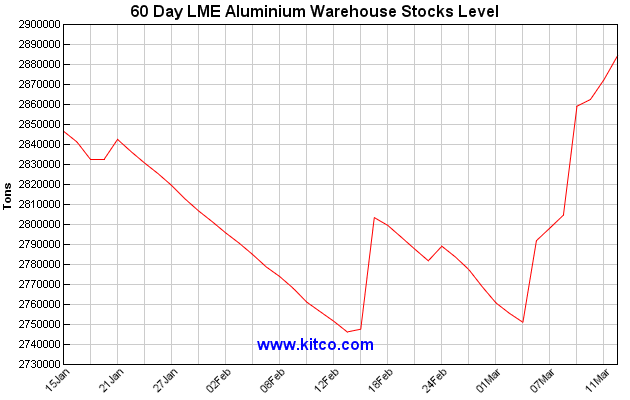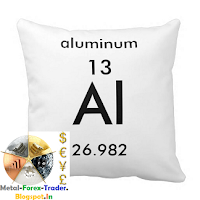While aluminium inventories appear high on paper, the market is quite tight
How can a market be burdened with millions of tonnes of excess stock and at the same time be prone to almost continuous tightness?
This is the conundrum posed by the aluminium contract traded on the London Metal Exchange. (LME). LME front-month spreads have just passed through another period of extreme turbulence.
At its most acute, on February 29, the cost of borrowing metal for the three weeks to the March prompt date flexed out to $29 per tonne. The cost of borrowing for a single day, known in the London market as ‘tom-next,’ reached almost $8.5 per tonne on March 3.
The benchmark cash-to-three-months period has so far this year spent twice as much time in backwardation as in contango.
Yet this is a market defined by massive legacy inventory. Most of it is ‘hidden’ in off-market storage — some say this is not less than 10 million tonnes.
Something’s not quite right. Maybe it’s the fact that for many months now someone has been holding much of the LME inventory and using that position to exert pressure on shorts rolling their positions forward. But that in itself is a sign of a more fundamental problem with the LME aluminium contract.
Last time, it was the disconnect between LME price and physical premiums. This time it’s the disconnect between nearby and forward spreads. There’s a worrying possibility that the LME’s solution to the first problem, attacking the persistent load-out queues in its delivery system, is now creating a new problem.
Who’s got the metal?
As of the close of business Tuesday one entity was holding between 50 and 80 per cent of all the ‘live’ stock in the LME system. That would make the position somewhere between 1.43 and 2.29 million tonnes.
As of the close of business Tuesday one entity was holding between 50 and 80 per cent of all the ‘live’ stock in the LME system. That would make the position somewhere between 1.43 and 2.29 million tonnes.
This is not news to anyone trading the LME aluminium market. That dominant position holder has been there for many months, albeit with a fluctuating amount of metal at any one time. This sort of long position requires very deep pockets.
And our ‘mystery long’ is not breaking any LME rules. The LME doesn’t prohibit such big positions but it does put limits on their potential abuse. In this case, such a massive holder of metal must lend to shorts at a prescribed rate. Moreover, the LME’s compliance department will have been in regular contact with this buyer.
Money out, stocks out
It is also becoming easier to squeeze the LME aluminium contract’s nearby dates. Firstly, the withdrawal of investment money from commodities by passive index investors, has reduced the amount of lending generated by funds rolling their long positions forward.
It is also becoming easier to squeeze the LME aluminium contract’s nearby dates. Firstly, the withdrawal of investment money from commodities by passive index investors, has reduced the amount of lending generated by funds rolling their long positions forward.
Secondly, the amount of underlying stock liquidity in the LME warehouse system has been steadily declining. ‘Live’ tonnage, meaning that which isn’t earmarked for physical withdrawal, hit a seven-year low of 1.63 million tonnes in December.
This year has seen that figure rebound to a current 2.87 million tonnes as previously cancelled metal has been re-warranted.
Distressed shorts have delivered fresh units into the system too. But not all of that headline figure on stocks is available for settlement of LME positions. Some of it is locked up in long-term financing deals.
The outlook is for LME stocks to continue declining over the medium term. This is where the LME’s increasingly draconian anti-queue rules are having an effect.
Accelerating outflows
Even while new aluminium units are arriving, ever increasing amounts are leaving. The daily load-out rate at Vlissingen, the location of the longest queue, has just accelerated from 3,000 to 4,000 tonnes per day.
Even while new aluminium units are arriving, ever increasing amounts are leaving. The daily load-out rate at Vlissingen, the location of the longest queue, has just accelerated from 3,000 to 4,000 tonnes per day.
That’s because Pacorini, the warehouse operator that ‘owns’ the queue at the Dutch port, is complying with the LME’s new elevated load-out rules.
The Vlissingen outflow will accelerate again from next month when another new rule, limiting the rent on queue-locked metal, kicks in. Most, if not all of this metal, is headed for off-market storage, which is considerably cheaper than LME storage. Warehouse rental is the single-biggest cost for metal financiers, who seek to make a return on the difference between short- and long-dated futures.
Stock financing is a core function of any commodity market. Consider the implications of it not being there and 10 million-plus tonnes of aluminium swamping the physical market.
Vicious circle?
But this financing function is creating a potentially vicious circle in the LME aluminium market right now. Those looking to move stocks out of the LME system will be rewarded with ever faster load-out.
But this financing function is creating a potentially vicious circle in the LME aluminium market right now. Those looking to move stocks out of the LME system will be rewarded with ever faster load-out.
The promise of faster outflow leaves the aluminium contract even more vulnerable to the sort of dominant-position pressures seen over the last couple of months. Unless the dominant long gives up, it’s difficult to see how this cycle is going to be broken. And even if the current buyer (long) does cash in, another one could just as easily play the same game, given the continuing migration of inventory from LME to off-market storage.
Aluminium looks set to continue to be plagued by LME delivery issues, just a whole different set of issues to last time. It would be deeply ironic if the solution to the previous abnormality is the cause of the new one. - Reuters
hindubusinessline



















